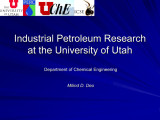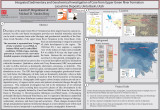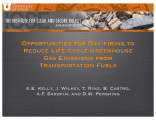TO
| Title | Date | Subject | Description | ||
|---|---|---|---|---|---|
| 51 |
 |
Industrial petroleum research at the University of Utah | 2008-03-12 | industrial petroleum; University of Utah; oil and gas characterization; oil and gas thermodynamics; Unconventional Consortium | Expertise: Oil and Gas Characterization, Hydrocarbon Thermodynamics -High-temperature, high high-pressure oil oil-gas mixtures -Supercritical extraction -Solid (asphaltenes, waxes) precipitation precipitation -Reservoir Characterization and Simulation -Fractured reservoir simulation -Reaction chemis... |
| 52 |
 |
Integrated sedimentary and geochemical investigation of core form the upper Green River Formation lacustrine deposits, Uinta Basin, Utah | 2010-04-12 | upper Green River formation; lacustrine deposits; geochemical investigation; lithofacies; facies | Description of the upper Green River Formation has been largely based on outcrop exposures, but this core-based investigation provides newly detailed subsurface data that can be used to examine basin-wide lithologic and geochemical variability of he Parachute Creek Member of the upper Green River Fo... |
| 53 |
 |
Interaction between reactivity and flow in the in-situ production of oil from oil shale | 2009-10-23 | in situ; oil shale | In-situ Oil Shale Processing: 1) Underground resources are heated by some means to convert insoluable/ impermeable kerogen into oil and gas products. 2) The interlinked processes of heat transfer, kerogen conversion and flow are complex. 3) This paper is an attempt to understand these linkages. |
| 54 |
 |
Investigation of coal char-slag transition during oxidation: Effect of temperature and residual carbon | 2009 | coal char; molten slag; bitumous coal; energy and fuels | The transition of coal char to molten slag at high conversion was studied for a bituminous coal using a laminar entrained-flow reactor under oxidizing conditions. Post-oxidized char particles were analyzed by various techniques including loss-on-ignition, gas adsorption analysis and scanning electro... |
| 55 |
 |
KTIA corporate introduction | 2009-02-27 | KTIA; KTI; mines | Overview of KTIA's continuing oil sands development activities in Utah, presented at the 2009 Western U.S. Oil Sands Conference by Soung-Joon Kim, Chief Operating Officer, Korea Technology Industry America, Inc. |
| 56 |
 |
Land and resource management issues relevant to deploying in-situ thermal technologies: Topical Report: October 1, 2009 to December 31, 2010 | 2011-01 | in-situ; oil shale; domestic energy source; oil sands | Utah is home to oil shale resources containing roughly 1.3 trillion barrels of oil equivalent and our nation's richest oil sands resources. If economically feasible and environmentally responsible means of tapping these resources can be developed, these resources could provide a safe and stable dome... |
| 57 |
 |
Lands with wilderness characteristics, Resource Management Plan constraints, and land exchanges: Cross-jurisdictional management and impacts on unconventional fuel development in Utah's Uinta Basin | 2012-03 | Utah oil shale; oil sands; unconventional fuel resources; land exchanges; land rights | Utah is rich in oil shale and oil sands resources. Chief among the challenges facing prospective unconventional fuel developers is the ability to access these resources. Access is heavily dependent upon land ownership and applicable management requirements. Understanding constraints on resource acce... |
| 58 |
 |
McLennan samples: Skyline | 2012-04-06 | Skyline; tight rock analysis; porosity | |
| 59 |
 |
Natural Gamma-Res Suite: Skyline 16 | 2010-05-28 | Gamma log; Skyline 16; natural gamma residue; NAT Gamma-RES Suite | Log concerning the natural gamma-res of Skyline 16. |
| 60 |
 |
North-South core-based cross section through the middle to upper Green River Formation, Uinta Basin, Utah - Plate 2 | 2014 | oil shale; economic oil shale; oil shale zone; cross section; Green River Formation; well log; core log | The top of economic oil shale was picked at the top of the lower R-8 zone (top of the Big Three rich oil shale beds). This zone was selected to avoid the abundant saline minerals found in the overlaying saline zone, which often contains high-TDS water. If saline minerals (and high-TDS water) do not ... |
| 61 |
 |
Opportunities for oxy-firing to reduce life-cycle greenhouse gas emissions from transportation fuels | 2011-03-10 | GHG; oxy-firing; reduce greenhouse gas emissions; transportation fuel emissions; CO2 analysis; oil sands | The outline covers in this presentation covers: GHGs and the transportation fuel cycle. Motivation for reducing GHG emissions. Use of oxy-firing for CO2 capture in refining of conventional fuel. Use of oxy-firing for extraction and upgrading of oil sands. GHG emissions from other scenarios Would oxy... |
| 62 |
 |
Oxy-coal combustion studies - Task 3 topical report, Utah Clean Coal Program. | 2014-08 | oxy-coal combustion; Utah Clean Coal Program; oxy-coal; large eddy simulations; near-flame aerodynamics; pilot-scale oxy-CFB; single-particle oxy char oxidation; ash partitioning; carbon capture; pulverized coal-fired power plants | The objective of this task is to move toward the development of a predictive capability with quantified uncertainty bounds for pilot-scale, single-burner, oxy-coal operation. This validation research brings together multi-scale experimental measurements and computer simulations. The combination of s... |
| 63 |
 |
Oxy-coal Combustion Studies Task 3 Topical Report, Utah Clean Coal Program | 2012-01-06 | oxy-coal combustion; Utah Clean Coal Program; carbon capture; large eddy simulations; near-field aerodynamics of oxy-coal flames; single-particle oxy-CO2 combustion; ash partitioning | The objective of this project is to move toward the development of a predictive capability with quantified uncertainty bounds for pilot-scale, single-burner, oxy-coal operation. This validation research brings together multi-scale experimental measurements and computer simulations. The combination o... |
| 64 |
 |
Oxy-fuel hierarchy | 2009-11-04 | oxy-fuel combustion; different fuel types; ICSE | Hierarchical chart for the oxy-fuel combustion research area showing connectivity between subtasks. This research area includes coal, gas, and oil oxy-burner technologies. This chart helps illustrate the integration and focus among the different fuel types and different scales represented in the hie... |
| 65 |
 |
Oxy-gas process heaters for efficient CO2 capture | 2010-04-28 | oil shale and oil sands technology; greenhouse gas emissions; GHG; large eddy simulation; LES; IFRF OXYFLAM | Implementation of oil shale/sands technologies in U.S. will require mitigation of greenhouse gas (GHG) emissions. |
| 66 |
 |
P. R. spring oil-impregnated sandstone deposit Uintah and Grand Counties, Utah | 1970-02 | oil-impregnated sandstone beds; oil impregnation; oil shale; lenticular sandstones; siltstones | Oil-impregnated sandstone beds underlie at least 214 square miles in the southeastern Uinta Basin and may extend northward beneath cover. One to as many as five principal saturated zones, 3 to 75 feet thick, occur in a 250-foot interval that dips gently northward. The northernmost outcrops are overl... |
| 67 |
 |
P4 Plate 6 | 2014 | well log; core log; plate 6; P4; White River Shale Project; Green River Formation | |
| 68 |
 |
Particle image velocimetry of pulverized oxy-coal flames | 2010-11-10 | oxy-fuel combustion of pulverized coal; oxy-fuel; pulverized coal; power production; carbon capture and sequestration; emission reductions | Oxy-fuel combustion of pulverized coal is a promising technology for cost-effective power production with carbon capture and sequestration that has impacts on emission reductions. To fully understand the behavior of turbulent oxy-coal flames, and to validate oxy-coal simulation models, accurate expe... |
| 69 |
 |
Phase 2: Clean and secure energy from coal: Quarterly progress report: April 1, 2010 to June 30, 2010 | 2010-08-01 | domestic coal resources; CO2 capture; stationary power generation; DQMOM approach | The University of Utah is pursuing research to utilize the vast energy stored in our domestic coal resources and to do so in a manner that will capture CO2 from combustion from stationary power generation. The research is organized around the theme of validation and uncertainty quantification throug... |
| 70 |
 |
Phase 2: Clean and secure energy from coal: Quarterly progress report: January 1, 2010 to March 31, 2010 | 2009-01-30 | domestic coal resources; ICSE; capture CO2; stationary power generation; velocity model; bitumous coal; coal | The University of Utah is pursuing research to utilize the vast energy stored in our domestic coal resources and to do so in a manner that will capture CO2 from combustion from stationary power generation. The research is organized around the theme of validation and uncertainty quantification throug... |
| 71 |
 |
Phase 2: Clean and secure energy from coal: Quarterly progress report: July 1, 2010 to September 30, 2010 | 2010-10-01 | domestic coal resources; CO2 capture; stationary power generation; Oxycoal; OFC; coal | The University of Utah is pursuing research to utilize the vast energy stored in our domestic coal resources and to do so in a manner that will capture CO2 from combustion from stationary power generation. The research is organized around the theme of validation and uncertainty quantification throug... |
| 72 |
 |
Phase 2: Clean and secure energy from coal: Quarterly progress report: October 1, 2009 to December 31, 2009 | 2010-01-30 | domestic coal resources; CO2 capture; stationary power generation; oxy-coal flames; coal gasification process | The University of Utah is pursuing research to utilize the vast energy stored in our domestic coal resources and to do so in a manner that will capture CO2 from combustion from stationary power generation. The research is organized around the theme of validation and uncertainty quantification throug... |
| 73 |
 |
Phase 2: Clean and secure energy from coal: Quarterly progress report: October 1, 2010 to December 31, 2010 | 2011-01-31 | domestic coal resources; CO2 capture; stationary power generation; LES; DQMOM approach; oxy-coal flames; coal | The University of Utah is pursuing research to utilize the vast energy stored in our domestic coal resources and to do so in a manner that will capture CO2 from combustion from stationary power generation. The research is organized around the theme of validation and uncertainty quantification throug... |
| 74 |
 |
Phase II: Clean and Secure Energy from Coal: Quarterly Progress Report: January 1, 2011 to March 30, 2011 | 2011-05-01 | domestic coal resources; CO2 capture; coal; Oxycoal simulation team; coal sequestration | The University of Utah is pursuing research to utilize the vast energy stored in our domestic coal resources and to do so in a manner that will capture CO2 from combustion from stationary power generation. The research is organized around the theme of validation and uncertainty quantification throug... |
| 75 |
 |
Policy analysis of produced water issues associated with in-situ thermal technologies: Topical report: October 1, 2009 to December 31, 2010 | 2011-01 | topical report; produced water issues; in situ thermal technologies; oil shale/sands; water rights; domestic energy source | Commercial scale oil shale and oil sands development will require water, the amount of which will depend on the technologies adopted and the scale of development that occurs. Water in oil shale and oil sands country is already in scarce supply, and because of the arid nature of the region and limita... |
